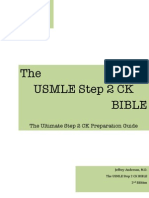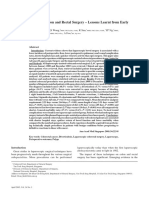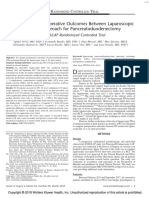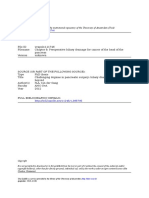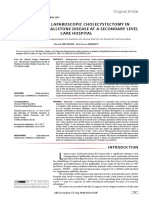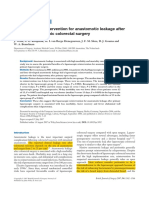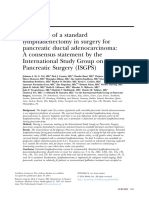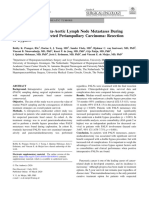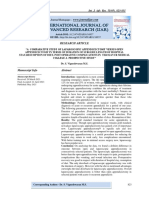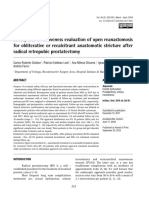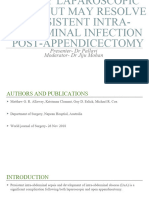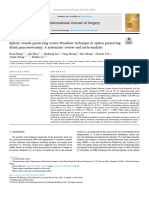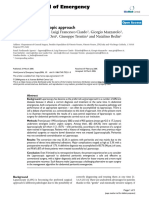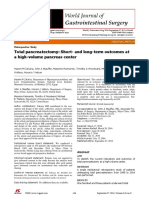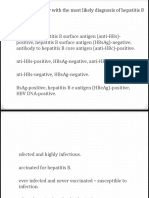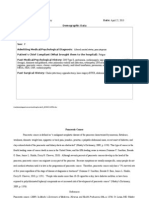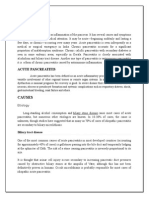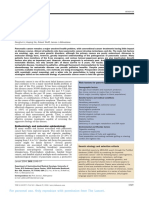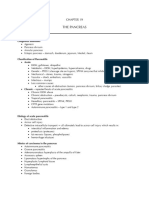1 Bjs 10662
1 Bjs 10662
Uploaded by
Vu Duy KienCopyright:
Available Formats
1 Bjs 10662
1 Bjs 10662
Uploaded by
Vu Duy KienOriginal Title
Copyright
Available Formats
Share this document
Did you find this document useful?
Is this content inappropriate?
Copyright:
Available Formats
1 Bjs 10662
1 Bjs 10662
Uploaded by
Vu Duy KienCopyright:
Available Formats
Randomized clinical trial
Randomized clinical trial of laparoscopic versus open
pancreatoduodenectomy for periampullary tumours
C. Palanivelu, P. Senthilnathan, S. C. Sabnis , N. S. Babu, S. Srivatsan Gurumurthy, N. Anand Vijai,
V. P. Nalankilli, P. Praveen Raj, R. Parthasarathy and S. Rajapandian
Department of Surgical Gastroenterology and Hepatopancreatobiliary Surgery, GEM Hospital and Research Centre, 45/A, Pankaja Mill Road,
Ramanathapuram Coimbatore, Tamil Nadu – 641045, India
Correspondence to: Dr S. C. Sabnis (e-mail: drsandeepsabnis@gmail.com; @drsandeepsabnis, @GEMHospitalCbe)
Background: Laparoscopic resection as an alternative to open pancreatoduodenectomy may yield
short-term benefits, but has not been investigated in a randomized trial. The aim of this study was to
compare laparoscopic and open pancreatoduodenectomy for short-term outcomes in a randomized trial.
Methods: Patients with periampullary cancers were randomized to either laparoscopic or open pan-
creatoduodenectomy. The outcomes evaluated were hospital stay (primary outcome), and blood loss,
radicality of surgery, duration of operation and complication rate (secondary outcomes).
Results: Of 268 patients, 64 who met the eligibility criteria were randomized, 32 to each group. The
median duration of postoperative hospital stay was longer for open pancreaticoduodenectomy than for
laparoscopy (13 (range 6–30) versus 7 (5–52) days respectively; P = 0⋅001). Duration of operation was
longer in the laparoscopy group. Blood loss was significantly greater in the open group (mean(s.d.) 401(46)
versus 250(22) ml; P < 0⋅001). Number of nodes retrieved and R0 rate were similar in the two groups.
There was no difference between the open and laparoscopic groups in delayed gastric emptying (7 of
32 versus 5 of 32), pancreatic fistula (6 of 32 versus 5 of 32) or postpancreatectomy haemorrhage (4 of
32 versus 3 of 32). Overall complications (defined according to the Clavien–Dindo classification) were
similar (10 of 32 versus 8 of 32). There was one death in each group.
Conclusion: Laparoscopy offered a shorter hospital stay than open pancreatoduodenectomy in this
randomized trial. Registration number: NCT02081131(http://www.clinicaltrials.gov).
Presented to a meeting of the International Hepato-Pancreato-Biliary Association, São Paulo, Brazil, April 2016;
published in abstract form as HPB 2016; 18: e3–e4
Paper accepted 6 July 2017
Published online in Wiley Online Library (www.bjs.co.uk). DOI: 10.1002/bjs.10662
Introduction tumours, their resection and reconstruction, made the
laparoscopic approach more difficult.
Until recently, the role of laparoscopy in pancreatic dis- Despite these barriers, with technical advances in instru-
eases was limited to staging laparoscopy and sometimes mentation coupled with growing expertise in recent years,
a palliative drainage procedure for unresectable malig- several surgeons across the world have acquired the nec-
nancies. Criticism of laparoscopic pancreatic resectional essary surgical skills to perform this procedure safely with
procedures, especially pancreatoduodenectomy, was based good results, and laparoscopic pancreatoduodenectomy is
on the fact that pancreas-specific complications are leading being performed more frequently for benign and malignant
causes of severe morbidity and mortality, irrespective of lesions1 . Laparoscopic pancreatoduodenectomy, although
approach. Although the benefits of minimally invasive technically difficult and requiring a high degree of exper-
surgery would remain for patients, pancreas-specific com- tise, has shown efficacy equal to that of open pancreato-
plications are not the obvious targets for improvement with duodenectomy in terms of complications, oncological
these approaches. In addition, factors such as the retroperi- safety and overall outcomes, with inherent advantages of
toneal location of this organ surrounded by vital structures, minimally invasive surgery such as decreased blood loss,
and the technically complex approach to pancreatic head reduced pain, shorter hospital stay and earlier return to
© 2017 BJS Society Ltd BJS 2017; 104: 1443–1450
Published by John Wiley & Sons Ltd
1444 C. Palanivelu, P. Senthilnathan, S. C. Sabnis, N. S. Babu, S. Srivatsan Gurumurthy, N. Anand Vijai et al.
work2 – 6 . Although a recent study7 from a high-volume surgery, blood loss, complication rate (using definitions of
centre reported concerns about greater morbidity for the the International Study Group of Pancreatic Surgery and
laparoscopic approach, with a higher pancreatic fistula the Clavien–Dindo classification)10 – 13 , and pathological
rate, a meta-analysis8 including more than 20 000 patients radicality of resection.
revealed favourable outcomes in well selected patients in At the interim analysis, the primary outcome variable
centres with a larger volume. was changed from complication rate to hospital stay, given
Although current reports from various centres support the insufficient sample size. The protocol was modified
use of laparoscopic resection, the studies so far are case with the approval of the hospital institutional review board,
series, case-matched comparisons or non-randomized and subsequent changes notified to the trial registration
trials. A randomized trial analysing open versus laparo- authorities.
scopic pancreatoduodenectomy has not been reported8 . The CONSORT statement guidelines14 were followed
The present study was therefore carried out as an RCT for reporting of the results.
to determine whether the laparoscopic approach is com-
parable to open pancreatoduodenectomy in terms of
Randomization
hospital stay, complications, oncological safety and overall
short-term outcomes. Simple randomization was done using a random number
table, with opaque sealed envelopes. The allocation was
Methods made through the inpatient admission section after con-
firmation of resectability by cross-sectional imaging and
This study was conducted from September 2013 to August staging laparoscopy.
2015 at a tertiary-care teaching institute in India. It was
a single-centre, non-stratified, balanced allocation (1:1)
open-label, parallel-group RCT. The study protocol was Data collection and initial evaluation
approved by the hospital ethics committee and was regis- On admission, demographic and anthropometric data were
tered prospectively at ClinicalTrials.gov as the PLOT trial recorded along with a detailed clinical history. Patients
(Pancreatic Head and Periampullary Cancer Laparoscopic underwent complete physical examination followed by lab-
versus Open Surgical Treatment; NCT02081131). oratory and radiological investigations. After establish-
All procedures were carried out in accordance with the ing the diagnosis, tumours were staged according to the
ethical standards of the responsible committee on human TNM classification (7th edition)15 and were discussed in
experimentation (institutional) and with the Helsinki Dec- a multidisciplinary tumour board meeting. Patients with
laration of 1964 and later versions along with Good Clin- potentially resectable tumours and deemed fit for surgery
ical Practice. Informed consent was obtained from all were considered for staging laparoscopy. Informed con-
patients for inclusion in the study. sent was obtained from the patient and family regarding
participation in the study, the possibility of undergoing
Inclusion and exclusion criteria either of the mentioned procedures, complications, and
Patients of either sex, aged 30–70 years, with a diagnosis expected outcomes. All patients, irrespective of final oper-
of resectable9 periampullary (distal cholangiocarcinoma, or ation, had an epidural catheter placed before the proce-
duodenal, ampullary or pancreatic head) cancer were eli- dure; the top-up dose in the postoperative period was
gible. Included were those with no radiological involve- decided by an anaesthetist, according to individual patient’s
ment of the superior mesenteric vein and portal vein, requirements. Patients were randomized after confirma-
and preserved fat planes between the tumour and coeliac tion of non-metastatic status into either the laparoscopy or
axis, hepatic artery and superior mesenteric artery. Patients open surgery group. The patients were grouped and sub-
undergoing initial surgery without previous chemotherapy sequently analysed based on the original randomization, in
were eligible, as well as those with no metastatic disease accordance with the intention-to-treat principle, irrespec-
after staging laparoscopy. Excluded were those found to tive of their final treatment.
have unresectable disease at the outset and those found to
have unresectable disease at a later stage of the procedure. Need for preoperative drainage
Preoperative biliary drainage (PBD) was not carried out
Study outcomes
routinely. The arbitrary cut-off for PBD in the present
The primary outcome variable was duration of postoper- study was a total bilirubin level of more than 20 mg/dl,
ative hospital stay. Secondary outcomes were duration of or other indications such as the presence of cholangitis or
© 2017 BJS Society Ltd www.bjs.co.uk BJS 2017; 104: 1443–1450
Published by John Wiley & Sons Ltd
Laparoscopic versus open pancreatoduodenectomy for periampullary tumours 1445
coagulopathy. The preferred method was by endoscopic discharge or death. The mean(s.d.) length of hospital stay
retrograde cholangiopancreatography with a plastic stent; for open pancreatoduodenectomy considered was 13(9⋅7)
if unsuccessful, percutaneous transhepatic biliary drainage days. Based on the authors’ experience and published
was used instead. Patients were considered for surgery only evidence, the mean length of hospital stay for laparo-
after the purpose of drainage had been achieved, that is scopic pancreatoduodenectomy was estimated at 6 days.
a bilirubin level of less than 5 mg/dl and freedom from To achieve a power of more than 80 per cent to detect
cholangitis; this usually took 3–4 weeks. differences in the two surgical groups and with a two-sided
test having a type I error of 0⋅05, with an effect size of
Surgery 7 days, it was calculated that 32 patients would be required
All the procedures were performed by either of the two in each group.
senior surgeons with sufficient experience of open and Continuous variables with a normal distribution are
laparoscopic pancreatoduodenectomy (more than 25 of reported as mean(s.d.) and those with a non-normal
each procedure). The hospital is a high-volume centre distribution as median (range). Student’s t test and
(over 40 pancreatoduodenectomies per year), with expe- Mann–Whitney U test respectively were used for analysis
rience of more than 150 procedures using a laparoscopic of these variables, and the χ2 test or Fisher’s exact test for
approach before the start of the present study16 . A verti- categorical variables. Variables with extreme values that
cal upper midline approach was preferred for open pan- skewed the data were analysed after omitting the outliers.
creatoduodenectomy and the procedure was performed in P < 0⋅050 was considered statistically significant. All sta-
accordance with the hospital protocol. A standard tech- tistical tests were done using SPSS® software version 17
nique was used for laparoscopic procedures, as described (IBM, Armonk, New York, USA).
previously2 . Pylorus preservation was attempted wherever
possible in both groups. Any deviation from standard oper- Results
ating techniques was reported by the operating surgeon.
After staging laparoscopy, 32 patients were randomized in
each group (Fig. 1). One patient in the laparoscopic group
Postoperative care had the procedure converted to open surgery, whereas two
After surgery, patients received an infusion of somatostatin patients who were initially allocated to the open group
(SOMASTAT; Solarase, Sun Pharmaceutical Industries, switched to the laparoscopic group as they refused to
Mumbai, India) at 120 μg/h for 3 days, and were observed undergo an open procedure. These patients were retained
in the ICU for 2 days. The decision to move the patient in their original allocated group for the intention-to-treat
out of the ICU was based on clinical improvement. Like- analysis.
wise, fluid management, nutritional support, oral feeds, Baseline characteristics were similar in the two groups
and removal of drains were decided based on the individ- (Table 1). Although PBD was not done routinely, 11
ual patient. Almost all components of enhanced recovery patients in the open group and eight in the laparoscopic
after surgery protocols for pancreatoduodenectomy17 were
incorporated (except with regard to use of somatostatin and
Table 1 Demographic and preoperative data
timing of drain removal, which were done according to
the institutional protocol). Complications, reinterventions Open (n = 32) Laparoscopic (n = 32)
and deaths were recorded. Patients were offered adjuvant Age (years)* 58⋅6(2⋅1) 57⋅8(2⋅0)
chemotherapy, according to final histopathology, and were Sex ratio (M : F) 22 : 10 18 : 14
advised to attend regular follow-up. BMI (kg/m2 )* 22⋅4(0⋅6) 24⋅9(0⋅7)
Co-morbidities‡ 17 15
Haemoglobin (g/dl)* 11⋅8(0⋅3) 11⋅9(0⋅3)
Pathological evaluation Albumin (mg/dl)* 3⋅8(0⋅1) 4⋅0(0⋅1)
Total bilirubin (mg/dl)* 7⋅2(1⋅2) 5⋅0(1⋅0)
The College of American Pathologists protocol18 was used CA19-9 (units/ml)*† 163⋅5(212⋅4) 577⋅2(518⋅1)
for preservation, labelling, processing and reporting of the Preoperative biliary drainage 11 8
ASA grade
specimens. I 11 13
II 18 17
III 3 2
Statistical analysis
*Values are mean(s.d.). †Extreme values excluded. ‡Diabetes mellitus,
The sample size calculation was based on the primary hypertension, asthma, chronic obstructive pulmonary disease,
outcome, length of hospital stay after index surgery until hypothyroidism and heart disease. CA, carbohydrate antigen.
© 2017 BJS Society Ltd www.bjs.co.uk BJS 2017; 104: 1443–1450
Published by John Wiley & Sons Ltd
1446 C. Palanivelu, P. Senthilnathan, S. C. Sabnis, N. S. Babu, S. Srivatsan Gurumurthy, N. Anand Vijai et al.
Assessed for eligibility n = 268
Excluded n = 204
Did not meet inclusion criteria n = 198
Metastatic disease at presentation n = 124
Enrolment
Metastasis identified during staging laparoscopy n = 13
Locally advanced disease on imaging n = 61
Poor performance status n = 2
Declined to participate n = 4
Randomized n = 64
Allocated to laparoscopic PD n = 32 Allocated to open PD n = 32
Allocation
Laparoscopic PD done n = 33 Open PD done n = 31
Switched from open PD group n = 2 Refused to undergo open PD; underwent
Conversion to open PD n = 1 laparoscopic PD n = 2
Conversion to open PD n = 1
Follow-up
Lost to follow-up to primary outcome n = 0 Lost to follow-up to primary outcome n = 0
Analysis
ITT analysis as laparoscopic PD n = 32 ITT analysis as open PD n = 32
Fig. 1 CONSORT diagram for the trial. PD, pancreatoduodenectomy, ITT, intention to treat
Table 2 Perioperative and postoperative variables
95 per cent c.i.
Open Laparoscopic for difference
(n = 32) (n = 32) (laparoscopic – open) P‡
Type of pancreatoduodenectomy 0⋅282
Pylorus-preserving 26 22
Classical 6 10
Vascular resection 3 1 0⋅071§
Pancreatic duct diameter (mm)* 4⋅5(0⋅2) 3⋅7(0⋅2) –1⋅3, 0⋅3 0⋅103¶
Duration of operation (min)* 320(13) 359(14) 2, 77 0⋅041¶
Blood loss (ml)* 401(46) 250(22) –254, –49 < 0⋅001¶
Blood transfusion 7 3 0⋅034
Conversion to open surgery – 1
Duration of ICU stay (days)† 3 (2–18) 2 (2–29) –3, 2 0⋅753#
Postoperative duration of hospital stay (days)† 13 (6–30) 7 (5–52) –7, –4 0⋅001#
Values are *mean(s.d.) and †median (range). ‡χ2 test, except §Fisher’s exact test, ¶Student’s t test and #Mann–Whitney U test.
group had a drainage procedure, mostly performed by the Duration of surgery was longer for laparoscopic
referring physician. procedures.
The type of pancreatoduodenectomy and related peri- There was one conversion from laparoscopy to open
operative data are summarized in Table 2. Analysis of the surgery, owing to concomitant vascular resection neces-
primary outcome showed that the duration of hospital sitating venous grafting. In total, there were four venous
stay was significantly shorter after laparoscopic compared resections, three in the open group and one in the
with open surgery (Table 2). As regards secondary out- laparoscopic group. Although vascular resection had an
comes, there were significant differences in blood loss impact on operative blood loss, the effect was not statisti-
and transfusion requirement that favoured laparoscopy. cally significant (P = 0⋅071). Subset comparison of blood
© 2017 BJS Society Ltd www.bjs.co.uk BJS 2017; 104: 1443–1450
Published by John Wiley & Sons Ltd
Laparoscopic versus open pancreatoduodenectomy for periampullary tumours 1447
loss between the two groups, after exclusion of patients Table 3 Postoperative complications
who had venous resection, confirmed the advantage of Open Laparoscopic
laparoscopy (P = 0⋅003), although it was reduced. (n = 32) (n = 32) P†
Postoperative complications were generally similar in Delayed gastric emptying* 7 5 0⋅603
the two groups. Only the rate of surgical-site infection Pancreatic fistula* 6 5 0⋅311
Grade A 2 3
differed significantly (8 of 32 in open group and 4 of 32
Grade B 3 1
in laparoscopic group; P = 0⋅015) (Table 3). Re-exploration Grade C 1 1
was required in one patient in each group. Postpancreatectomy haemorrhage* 4 3 0⋅396
Grade A 2 1
There was one death in hospital within 90 days in each
Grade B 1 1
group (3 per cent). The patient in the laparoscopic group Grade C 1 1
developed multiple spontaneous perforations involving Postoperative collection 5 4 0⋅860
the small bowel on postoperative day 8, and underwent Surgical-site infection 8 4 0⋅015
Superficial 5 2
re-exploration twice with bowel resection, but died from Deep 3 2
septicaemia and shock. The patient in the open group was Bile leak 2 3 0⋅419
an elderly man who developed portal vein thrombosis that Systemic complications 8 6 0⋅331
Clavien–Dindo grade 10 8 0⋅752‡
was managed with anticoagulation. He deteriorated fur- I 5 3
ther, developing disseminated intravascular coagulation, II 1 2
leading to acute renal failure and death. III 2 2
IV 1 0
V 1 1
Re-exploration 1 1 –
Death 1 1 –
Readmissions Readmission 3 2 0⋅763
During a short follow-up of 90 days, five patients required *According to International Study Group of Pancreatic Surgery
readmission, three in the open and two in the laparoscopic definitions. †Fisher’s exact test, except ‡χ2 test.
group. Reasons were: secondary suturing of the wound (2),
Histopathological analysis
persistent pancreatic fistula (1), aesthenia (1) and recurrent
vomiting due to stomal oedema (gastrojejunostomy) (1). Tumour size and the rate of R0 resection were similar
None of them had evidence of recurrence. in the two groups (Table 4). The mean(s.d.) number of
Table 4 Histopathology data
Open Laparoscopic 95 per cent c.i. for difference
(n = 32) (n = 32) (laparoscopic – open) P‡
Type of pancreatic tumour
Ampullary 11 15
Duodenal 7 10
Distal cholangiocarcinoma 6 4
Pancreatic head 8 3
Differentiation
Well differentiated 3 7
Moderately differentiated 26 25
Poorly differentiated 3 0
Tumour size (cm)* 3⋅6(1⋅9) 3⋅3(0⋅7) –4⋅5, 0⋅9 0⋅437§
R0 margin 30 31 0⋅128
No. of lymph nodes retrieved* 17⋅0(1⋅4) 18⋅9(1⋅0) –1⋅7, 5⋅6 0⋅063§
No. of positive nodes† 1 (0–19) 0⋅5 (0–22) –3, 2 0⋅831¶
% positive nodes* 15⋅4(3⋅9) 13⋅2(3⋅7) –13⋅0, 8⋅6 0⋅751§
TNM stage
IA 3 4
IIA 6 7
IIB 8 5
IIIA 12 14
IIIB 3 2
Perineural invasion 9 6 0⋅002
Lymphovascular invasion 3 2 0⋅664#
Values are *mean(s.d.) and †median (range). ‡χ2 test, except §Student’s t test, ¶Mann–Whitney U test and #Fisher’s exact test.
© 2017 BJS Society Ltd www.bjs.co.uk BJS 2017; 104: 1443–1450
Published by John Wiley & Sons Ltd
1448 C. Palanivelu, P. Senthilnathan, S. C. Sabnis, N. S. Babu, S. Srivatsan Gurumurthy, N. Anand Vijai et al.
lymph nodes retrieved in the open and laparoscopic groups the present study, there were three venous resections in
were 17⋅0(1⋅4) and 18⋅9(1⋅0) respectively (P = 0⋅063). Nine the open group and one in the laparoscopic group. Con-
patients in the open group and six in the laparoscopic group comitant venous resections represent an important indi-
had perineural invasion (P = 0⋅002), which may reflect later cation for conversion, as was the case here. However, of
in the form of recurrence, or could influence long-term late, studies with a high percentage of venous resections
survival. (17–20 per cent) during laparoscopic procedures have been
reported19,27 .
The mean number of lymph nodes removed was sim-
Discussion
ilar in the laparoscopic and open groups, demonstrating
This randomized trial comparing laparoscopic with open that laparoscopy provides equivalent nodal clearance. Sim-
pancreatoduodenectomy suggested that laparoscopy offers ilar nodal counts have been mentioned by Hakeem and
significant benefit in terms of hospital stay, which was colleagues5 and Croome et al.21 . The R0 resection rate was
the primary outcome of this study. Differences in blood also comparable in the two groups.
loss, transfusion requirements, and wound-related compli- This study has a number of limitations, including the
cations were noted. The laparoscopic approach was sim- small sample size. The study was adequately powered for
ilar to the open procedure regarding other complications analysis of length of hospital stay, but underpowered to
and short-term mortality. The benefits of laparoscopic pan- detect differences in complication rates. Short-term results
creatoduodenectomy in terms of disease-free survival and (90 days) are presented here, but other outcomes were not
long-term survival were not investigated. assessed, such as recurrence and survival (disease-free and
Since the beginning of this decade, several reports5,19 – 23 overall), and long-term complications that become appar-
from other centres have documented comparative data for ent on longer follow-up. As there were more pancreatic
these two procedures. However, until now, no randomized cancers in the open group, this group would be expected to
trial existed. fare worse in terms of disease-specific survival. Finally, the
This study demonstrated a significant advantage for the institutional setting of the present study, with a high case
laparoscopic group in terms of shortened median duration volume and expertise in advanced laparoscopic surgery, and
of postoperative hospital stay, which was decreased by half relatively non-obese patients, probably contributed to low
compared with that of open surgery. Certain other fac- morbidity and mortality rates, and comparable outcomes
tors that can influence length of stay are bile leak, wound in the study groups; the results should therefore be viewed
infection and intra-abdominal collections, as reported by from that perspective, especially with regard to external
others21,24 . The authors believe that the shorter hospital application.
stay can be partly explained by these factors, but was also It is an extremely challenging task to perform a pro-
likely to have been influenced by patients’ perception of cedure like laparoscopic pancreatoduodenectomy safely
major abdominal surgery based on the incision length as and without compromising outcomes. There is an urgent
they were not blinded to the intervention. Mean operat- need for standardization, as the popularity of laparo-
ing times in this study were 320 min for the open group scopic pancreatic resections is rising, and international
and 359 min for the laparoscopic group; although the dif- efforts have been made in the form of guidelines28,29 .
ference is small, it is statistically significant (P = 0⋅041). Further trials with larger numbers of patients are needed
Previous comparative studies19,23 have reported an oper- to clarify the complications and oncological outcomes
ating time for open surgery similar to that in the present with adequate statistical power. The multi-institutional
study, but a longer duration for laparoscopy, which may be pragmatic LEOPARD-2 trial (NTR5689) from the
explained partly by a higher percentage of venous resec- Netherlands and the single-centre PADULAP trial
tions involved. The authors have observed that a com- (ISRCTN93168938) from Spain will possibly contribute
plex procedure like laparoscopic pancreatoduodenectomy further evidence.
has a long learning curve; with experience, the operat-
ing time improved, but then reached a plateau at around Acknowledgements
320–350 min2,16,25 .
The laparoscopic approach was better regarding blood The authors thank V. Kate (Department of Surgery,
loss and transfusion requirements in this study, but the Jawaharlal Institute of Postgraduate Medical Education
difference was less pronounced when procedures with and Research, Pondicherry, India) for critical review and
venous resection were excluded. Similar advantages of suggestions.
decreased blood loss have been reported by others21,26 . In Disclosure: The authors declare no conflict of interest.
© 2017 BJS Society Ltd www.bjs.co.uk BJS 2017; 104: 1443–1450
Published by John Wiley & Sons Ltd
Laparoscopic versus open pancreatoduodenectomy for periampullary tumours 1449
References 14 Schulz KF, Altman DG, Moher D; CONSORT Group.
CONSORT 2010 statement: updated guidelines for
1 Jin T, Altaf K, Xiong JJ, Huang W, Javed MA, Mai G et al.
reporting parallel group randomised trials. BMJ 2010; 340:
A systematic review and meta-analysis of studies comparing
c332.
laparoscopic and open distal pancreatectomy. HPB (Oxford)
15 Edge S, Byrd DR, Compton CC, Fritz AG, Greene FL,
2012; 14: 711–724.
Trotti A (eds). AJCC Cancer Staging Manual (7th edn).
2 Palanivelu C, Rajan PS, Rangarajan M, Vaithiswaran V,
Springer: New York, 2010.
Senthilnathan P, Parthasarathi R et al. Evolution in
16 Senthilnathan P, Srivatsan Gurumurthy S, Gul SI, Sabnis S,
techniques of laparoscopic pancreaticoduodenectomy: a
Natesan AV, Palanisamy NV et al. Long-term results of
decade long experience from a tertiary center. J Hepatobiliary
laparoscopic pancreaticoduodenectomy for pancreatic and
Pancreat Surg 2009; 16: 731–740.
periampullary cancer – experience of 130 cases from a
3 Asbun HJ, Stauffer J. Laparoscopic vs open
tertiary-care center in South India. J Laparoendosc Adv Surg
pancreaticoduodenectomy: overall outcomes and severity of
Tech A 2015; 25: 295–300.
complications using the Accordion Severity Grading
System. J Am Coll Surg 2012; 215: 810–819. 17 Lassen K, Coolsen MME, Slim K, Carli F, De
4 Cho A, Yamamoto H, Nagata M, Takiguchi N, Shimada H, Aguilar-Nascimento JE, Schäfer M et al.; Enhanced
Kainuma O et al. A totally laparoscopic pylorus-preserving Recovery After Surgery (ERAS) Society, for Perioperative
pancreaticoduodenectomy and reconstruction. Surg Today Care; European Society for Clinical Nutrition and
2009; 39: 359–362. Metabolism (ESPEN); International Association for
5 Hakeem AR, Verbeke CS, Cairns A, Aldouri A, Smith AM, Surgical Metabolism and Nutrition (IASMEN). Guidelines
Menon KV. A matched-pair analysis of laparoscopic versus for perioperative care for pancreaticoduodenectomy:
open pancreaticoduodenectomy: oncological outcomes Enhanced Recovery After Surgery (ERAS®) Society
using Leeds Pathology Protocol. Hepatobiliary Pancreat Dis recommendations. World J Surg 2013; 37: 240–258.
Int 2014; 13: 435–441. 18 Washington MK, Berlin J, Branton PA, Burgart LJ, Carter
6 Wei H, Wei B, Zheng Z, Huang Y, Huang J, Fang J. DK, Compton CC et al.; Members of the Cancer
[Comparative study of outcomes after laparoscopic versus Committee, College of American Pathologists. Protocol for
open pancreaticoduodenectomy.] Zhonghua Wei Chang Wai the examination of specimens from patients with carcinoma
Ke Za Zhi 2014; 17: 465–468. of the intrahepatic bile ducts. Arch Pathol Lab Med 2010;
7 Dokmak S, Ftériche FS, Aussilhou B, Bensafta Y, Lévy P, 134: e14–e18.
Ruszniewski P et al. Laparoscopic pancreaticoduodenectomy 19 Mesleh MG, Stauffer JA, Bowers SP, Asbun HJ. Cost
should not be routine for resection of periampullary tumors. analysis of open and laparoscopic pancreaticoduodenectomy:
J Am Coll Surg 2015; 220: 831–838. a single institution comparison. Surg Endosc 2013; 27:
8 de Rooij T, Lu MZ, Steen MW, Gerhards MF, Dijkgraaf 4518–4523.
MG, Busch OR et al. Minimally invasive versus open 20 Song KB, Kim SC, Hwang DW, Lee JH, Lee DJ, Lee JW
pancreatoduodenectomy. Ann Surg 2016; 264: 257–267. et al. Matched case–control analysis comparing laparoscopic
9 Evans DB, Farnell MB, Lillemoe KD, Vollmer C, Strasberg and open pylorus-preserving pancreaticoduodenectomy in
SM, Schulick RD. Surgical treatment of resectable and patients with periampullary tumors. Ann Surg 2015; 262:
borderline resectable pancreas cancer: expert consensus 146–155.
statement. Ann Surg Oncol 2009; 16: 1736–1744. 21 Croome KP, Farnell MB, Que FG, Reid-Lombardo KM,
10 Bassi C, Dervenis C, Butturini G, Fingerhut A, Yeo C, Truty MJ, Nagorney DM et al. Total laparoscopic
Izbicki J et al. Postoperative pancreatic fistula: an pancreaticoduodenectomy for pancreatic ductal
international study group (ISGPF) definition. Surgery 2005; adenocarcinoma: oncologic advantages over open
138: 8–13. approaches? Ann Surg 2014; 260: 633–638.
11 Wente MN, Veit JA, Bassi C, Dervenis C, Fingerhut A, 22 Sharpe SM, Talamonti MS, Wang CE, Prinz RA, Roggin
Gouma DJ et al. Postpancreatectomy hemorrhage (PPH): an KK, Bentrem DJ et al. Early national experience with
International Study Group of Pancreatic Surgery (ISGPS) laparoscopic pancreaticoduodenectomy for ductal
definition. Surgery 2007; 142: 20–25. adenocarcinoma: a comparison of laparoscopic
12 Wente MN, Bassi C, Dervenis C, Fingerhut A, Gouma DJ, pancreaticoduodenectomy and open
Izbicki JR et al. Delayed gastric emptying (DGE) after pancreaticoduodenectomy from the National Cancer Data
pancreatic surgery: a suggested definition by the Base. J Am Coll Surg 2015; 221: 175–184.
International Study Group of Pancreatic Surgery (ISGPS). 23 Tan C-L, Zhang H, Peng B, Li K-Z. Outcome and costs of
Surgery 2007; 142: 761–768. laparoscopic pancreaticoduodenectomy during the initial
13 Dindo D, Demartines N, Clavien PA. Classification of learning curve vs laparotomy. World J Gastroenterol 2015; 21:
surgical complications: a new proposal with evaluation in a 5311–5319.
cohort of 6336 patients and results of a survey. Ann Surg 24 Sewnath ME, Karsten TM, Prins MH, Rauws EJA, Obertop
2004; 240: 205–213. H, Gouma DJ. A meta-analysis on the efficacy of
© 2017 BJS Society Ltd www.bjs.co.uk BJS 2017; 104: 1443–1450
Published by John Wiley & Sons Ltd
1450 C. Palanivelu, P. Senthilnathan, S. C. Sabnis, N. S. Babu, S. Srivatsan Gurumurthy, N. Anand Vijai et al.
preoperative biliary drainage for tumors causing obstructive versus open approaches. J Gastrointest Surg 2015; 19:
jaundice. Ann Surg 2002; 236: 17–27. 189–194.
25 Palanivelu C, Jani K, Senthilnathan P, Parthasarathi R, 28 Hogg ME, Besselink MG, Clavien P-A, Fingerhut A,
Rajapandian S, Madhankumar MV. Laparoscopic Jeyarajah DR, Kooby DA et al.; Minimally Invasive
pancreaticoduodenectomy: technique and outcomes. J Am Pancreatic Resection Organizing Committee. Training in
Coll Surg 2007; 205: 222–230. minimally invasive pancreatic resections: a paradigm shift
26 Langan RC, Graham JA, Chin AB, Rubinstein AJ, Oza K, away from ‘see one, do one, teach one’. HPB (Oxford) 2017;
Nusbaum JA et al. Laparoscopic-assisted versus open 19: 234–245.
pancreaticoduodenectomy: early favorable physical 29 Edwin B, Sahakyan MA, Abu Hilal M, Besselink MG, Braga
quality-of-life measures. Surgery 2014; 156: 379–384. M, Fabre JM et al.; EAES Consensus Conference Study
27 Croome KP, Farnell MB, Que FG, Reid-Lombardo KM, Group. Laparoscopic surgery for pancreatic neoplasms: the
Truty MJ, Nagorney DM et al. Pancreaticoduodenectomy European Association for Endoscopic Surgery clinical
with major vascular resection: a comparison of laparoscopic consensus conference. Surg Endosc 2017; 31: 2023–2041.
Editor’s comments
Laparoscopic and open pancreatoduodenectomy are for the first time studied in a randomized trial, and the authors are
to be congratulated for this effort. The background, rationale and incentives for doing the trial, as well as the choice of
endpoint, will be subject to discussion and interpretation from both its proponents and sceptics. The study showed a
remarkable benefit as it halved the median length of hospital stay in the laparoscopic group, the primary endpoint of the
study. The range of hospital stay did not differ, so laparoscopy can only partially explain this difference. Interpretation
of blood loss and transfusion is troubling as the few patients who had venous resection included confounded these
measures. Morbidity and mortality did not differ, but the study was not powered for this. Most would await long-term
outcomes to conclude robustly on the oncological safety of laparoscopy. However, this trial may not give robust data
on survival as the number of pancreatic cancers was much higher in the open compared with the laparoscopic surgery
group (8 of 32 versus 3 of 32), and will thus influence overall survival. Several new questions arise from this first trial
that need to be addressed before real equivalence, benefit or harm can be stated.
K. Søreide
Editor, BJS
© 2017 BJS Society Ltd www.bjs.co.uk BJS 2017; 104: 1443–1450
Published by John Wiley & Sons Ltd
You might also like
- Step 2 CK BibleDocument435 pagesStep 2 CK Biblewilksebas100% (13)
- Doctor Who Cures CancerDocument397 pagesDoctor Who Cures CancerAshiraChayilNo ratings yet
- A Prospective Treatment Protocol For Outpatient Laparoscopic Appendectomy For Acute AppendicitisDocument5 pagesA Prospective Treatment Protocol For Outpatient Laparoscopic Appendectomy For Acute AppendicitisBenjamin PaulinNo ratings yet
- Bun V34N3p223Document6 pagesBun V34N3p223pingusNo ratings yet
- Laparoscopic Vs Open Appendectomy: Which Way To Go?Document22 pagesLaparoscopic Vs Open Appendectomy: Which Way To Go?fahryzal_noteNo ratings yet
- Art07 PDFDocument6 pagesArt07 PDFadan2010No ratings yet
- Complicated AppendicitisDocument4 pagesComplicated AppendicitisMedardo ApoloNo ratings yet
- 268 2011 Article 1088 PDFDocument6 pages268 2011 Article 1088 PDFIoel Tovar TrovaNo ratings yet
- Kimura Vs OpenDocument7 pagesKimura Vs OpenmenishefNo ratings yet
- Strobel 2015Document9 pagesStrobel 2015Prasad NeelamNo ratings yet
- Comparison of Perioperative Outcomes Between Laparoscopic and Open Approach For PancreatoduodenectomyDocument9 pagesComparison of Perioperative Outcomes Between Laparoscopic and Open Approach For PancreatoduodenectomyVu Duy KienNo ratings yet
- Reoperative Antireflux Surgery For Failed Fundoplication: An Analysis of Outcomes in 275 PatientsDocument8 pagesReoperative Antireflux Surgery For Failed Fundoplication: An Analysis of Outcomes in 275 PatientsDiego Andres VasquezNo ratings yet
- Downloaded From Uva-Dare, The Institutional Repository of The University of Amsterdam (Uva)Document15 pagesDownloaded From Uva-Dare, The Institutional Repository of The University of Amsterdam (Uva)Pra YudhaNo ratings yet
- Isj-5899 oDocument5 pagesIsj-5899 oAbhiram MundleNo ratings yet
- Editorial: Percutaneous Drainage of Liver Hydatid Cysts: Is Evidence Enough To Accept It As First Modality of Choice?Document3 pagesEditorial: Percutaneous Drainage of Liver Hydatid Cysts: Is Evidence Enough To Accept It As First Modality of Choice?David CerrónNo ratings yet
- Versus: Laparoscopic Open Appendectomy: Which Way To Go?Document6 pagesVersus: Laparoscopic Open Appendectomy: Which Way To Go?Claudiu Ungureanu ClauNo ratings yet
- Bahasa IndonesiaDocument4 pagesBahasa IndonesiaNadiah Umniati SyarifahNo ratings yet
- Comparison of Open and Laproscopic Live Donor NephrectomyDocument7 pagesComparison of Open and Laproscopic Live Donor NephrectomyEhab Omar El HalawanyNo ratings yet
- The Incidence and Risk of Early Postoperative Small Bowel Obstruction After Laparoscopic Resection For Colorectal Cancer 2014Document7 pagesThe Incidence and Risk of Early Postoperative Small Bowel Obstruction After Laparoscopic Resection For Colorectal Cancer 2014alemago90No ratings yet
- Cytoreductive Surgery and IntraperitonealDocument11 pagesCytoreductive Surgery and IntraperitonealJorge FallasNo ratings yet
- Wind2007 PDFDocument5 pagesWind2007 PDFanatolioNo ratings yet
- Could Laparoscopic Colon and Rectal Surgery Become The Standard of Care? A Review and Experience With 750 ProceduresDocument9 pagesCould Laparoscopic Colon and Rectal Surgery Become The Standard of Care? A Review and Experience With 750 ProcedurespingusNo ratings yet
- Apendisitis MRM 3Document8 pagesApendisitis MRM 3siti solikhaNo ratings yet
- Daneshmand 2014Document7 pagesDaneshmand 2014granmarado10No ratings yet
- Unukovych 2016Document7 pagesUnukovych 2016jdavies231No ratings yet
- Tiwari 2011Document6 pagesTiwari 2011syeda rabikaNo ratings yet
- Laparoscopic Appendectomy PostoperativeDocument6 pagesLaparoscopic Appendectomy PostoperativeDamal An NasherNo ratings yet
- Fonc 09 00597Document13 pagesFonc 09 00597Giann PersonaNo ratings yet
- Linfadenectomy in Pancreatic Adenoca Definition Isgps 2014Document10 pagesLinfadenectomy in Pancreatic Adenoca Definition Isgps 2014CIRUGÍA ONCOLÓGICA ABDOMENNo ratings yet
- Tecnica de Clips Nefrectomia ParcialDocument8 pagesTecnica de Clips Nefrectomia ParcialAlfredo BalcázarNo ratings yet
- 9 Management of Common Bile-Duct Stones and Associated Gallbladder Stones: Surgical AspectsDocument14 pages9 Management of Common Bile-Duct Stones and Associated Gallbladder Stones: Surgical AspectsekoNo ratings yet
- qt5kh1c39r NosplashDocument12 pagesqt5kh1c39r NosplashSusieNo ratings yet
- JC 15 Literature Review 1Document10 pagesJC 15 Literature Review 1menishefNo ratings yet
- @medicinejournal European Journal of Pediatric Surgery January 2020Document126 pages@medicinejournal European Journal of Pediatric Surgery January 2020Ricardo Uzcategui ArreguiNo ratings yet
- Corto y Largo PlazoDocument6 pagesCorto y Largo PlazoElard Paredes MacedoNo ratings yet
- Comparison of Laparoscopic vs. Open Surgery For Rectal CancerDocument7 pagesComparison of Laparoscopic vs. Open Surgery For Rectal Cancermohammed askarNo ratings yet
- Journal Homepage: - : Manuscript HistoryDocument9 pagesJournal Homepage: - : Manuscript HistoryIJAR JOURNALNo ratings yet
- Safety and Effectiveness Evaluation of Open Reanastomosis For Obliterative or Recalcitrant Anastomotic Stricture After Radical Retropubic ProstatectomyDocument9 pagesSafety and Effectiveness Evaluation of Open Reanastomosis For Obliterative or Recalcitrant Anastomotic Stricture After Radical Retropubic Prostatectomyjuan jose velascoNo ratings yet
- MOC IV 2014 Laparoscopy and Elective Colon Resection June 2012Document18 pagesMOC IV 2014 Laparoscopy and Elective Colon Resection June 2012pingusNo ratings yet
- LAPAROSDocument13 pagesLAPAROSpancholin_9No ratings yet
- Laproscopic Vagotony PaperDocument4 pagesLaproscopic Vagotony Paperpeter_mrNo ratings yet
- Liver A BSC DrainDocument8 pagesLiver A BSC DrainAngelica AmesquitaNo ratings yet
- Presentation 5Document23 pagesPresentation 5pallaviNo ratings yet
- Kurum Boor 2016Document4 pagesKurum Boor 2016Chema ToledoNo ratings yet
- Utd 04524 Clinical - Article KunduzDocument5 pagesUtd 04524 Clinical - Article Kunduzzenatihanen123No ratings yet
- Pancreatic PseudocystDocument9 pagesPancreatic Pseudocystlee2652No ratings yet
- International Journal of Surgery Open: Tariq Al-Aubaidi, Basim R. Ghadhban, Samer S. ChitheerDocument7 pagesInternational Journal of Surgery Open: Tariq Al-Aubaidi, Basim R. Ghadhban, Samer S. Chitheersamer falconNo ratings yet
- Laparoscopic Appendectomy For Complicated Appendicitis - An Evaluation of Postoperative Factors.Document5 pagesLaparoscopic Appendectomy For Complicated Appendicitis - An Evaluation of Postoperative Factors.Juan Carlos SantamariaNo ratings yet
- Original Research ArticleDocument9 pagesOriginal Research ArticleAnand ShanmugaiahNo ratings yet
- WarshawDocument11 pagesWarshawJuan RamirezNo ratings yet
- Ileus Obstruksi PDFDocument20 pagesIleus Obstruksi PDFherfikaNo ratings yet
- Guillot Re Au 2009Document6 pagesGuillot Re Au 2009nimaelhajjiNo ratings yet
- Cutaneous Needle Aspirations in Liver DiseaseDocument6 pagesCutaneous Needle Aspirations in Liver DiseaseRhian BrimbleNo ratings yet
- EASY TrialDocument8 pagesEASY TrialDpxeir PapanikolaouNo ratings yet
- Timing of Surgical Resection For Curative Colorectal Cancer With Liver MetastasisDocument6 pagesTiming of Surgical Resection For Curative Colorectal Cancer With Liver MetastasisdorissjbNo ratings yet
- Laparaskopi PeritonitisDocument5 pagesLaparaskopi PeritonitisPutri RiszaNo ratings yet
- Total Pancreatectomy: Short-And Long-Term Outcomes at A High-Volume Pancreas CenterDocument10 pagesTotal Pancreatectomy: Short-And Long-Term Outcomes at A High-Volume Pancreas CenterJherinNo ratings yet
- Intravenous Fluid Therapy in The Adult Surgic 2016 International Journal ofDocument1 pageIntravenous Fluid Therapy in The Adult Surgic 2016 International Journal ofoomculunNo ratings yet
- Literature Review On Pancreatic CancerDocument8 pagesLiterature Review On Pancreatic Cancerea86yezd100% (1)
- 014 - Primary-Colorectal-Cancer - 2023 - Surgical-Oncology-Clinics-of-North-AmericaDocument16 pages014 - Primary-Colorectal-Cancer - 2023 - Surgical-Oncology-Clinics-of-North-AmericaDr-Mohammad Ali-Fayiz Al TamimiNo ratings yet
- Atlas of Laparoscopic Gastrectomy for Gastric Cancer: High Resolution Image for New Surgical TechniqueFrom EverandAtlas of Laparoscopic Gastrectomy for Gastric Cancer: High Resolution Image for New Surgical TechniqueNo ratings yet
- The SAGES Manual of Flexible EndoscopyFrom EverandThe SAGES Manual of Flexible EndoscopyPeter NauNo ratings yet
- Pancreatic AdenocarcinomaDocument6 pagesPancreatic AdenocarcinomafikriafisNo ratings yet
- Pancreatic Enzyme Extract Improves Survival in Murine Pancreatic CancerDocument12 pagesPancreatic Enzyme Extract Improves Survival in Murine Pancreatic CancerRexGoliathNo ratings yet
- Pathology of PancreasDocument86 pagesPathology of PancreasMohammad zreadNo ratings yet
- Pancreas and SpleenDocument106 pagesPancreas and SpleenJorge De Vera100% (1)
- The Journal of Pathology - 2023 - Jones - Recent Advances in Pathology The 2023 Annual Review Issue of The Journal ofDocument3 pagesThe Journal of Pathology - 2023 - Jones - Recent Advances in Pathology The 2023 Annual Review Issue of The Journal ofShahid ShaikhNo ratings yet
- Artery First Approach To Pancreatic Cancer Resection A Review of The Evidence For BenefitDocument3 pagesArtery First Approach To Pancreatic Cancer Resection A Review of The Evidence For BenefitFlaviu Ionuț FaurNo ratings yet
- Persuasive Writing Gcse CourseworkDocument7 pagesPersuasive Writing Gcse Courseworksyn0wok0pym3100% (2)
- GemcitabineDocument6 pagesGemcitabineCaballero X CaballeroNo ratings yet
- शल्यतन्त्र Paper II, Part BDocument79 pagesशल्यतन्त्र Paper II, Part BAnil DasNo ratings yet
- Clinical Worksheet: /var/www/apps/conversion/tmp/scratch - 2/182114054Document20 pagesClinical Worksheet: /var/www/apps/conversion/tmp/scratch - 2/182114054jenn1722No ratings yet
- CancerDocument2 pagesCancerkatyaNo ratings yet
- PancreatitisDocument23 pagesPancreatitissalmanhabeebekNo ratings yet
- ACG Guideline AcutePancreatitis September 2013Document16 pagesACG Guideline AcutePancreatitis September 2013gorditomaloNo ratings yet
- ThesisDocument75 pagesThesisleartaNo ratings yet
- Pure Patho PDFDocument9 pagesPure Patho PDFlovlyNo ratings yet
- Perfusion 1Document12 pagesPerfusion 1zixdiddyNo ratings yet
- Arab Board Exam 2017 - Paper 2Document18 pagesArab Board Exam 2017 - Paper 2ghassanNo ratings yet
- Alex Trebek LetterDocument3 pagesAlex Trebek LetterandrewNo ratings yet
- Get Diagnostic Ultrasound: Abdomen and Pelvis 2nd Edition Aya Kamaya Free All ChaptersDocument64 pagesGet Diagnostic Ultrasound: Abdomen and Pelvis 2nd Edition Aya Kamaya Free All Chapterscilinecayni48100% (4)
- PNET - 2020 Update On Pathologic, Imaging Findings and ClassificationsDocument23 pagesPNET - 2020 Update On Pathologic, Imaging Findings and ClassificationsSamuel WidjajaNo ratings yet
- Clinical G. I. Surgery: Book ReviewDocument2 pagesClinical G. I. Surgery: Book Reviewyacine tarikNo ratings yet
- Chronic PancreatitisDocument8 pagesChronic PancreatitisSanjaya SenevirathneNo ratings yet
- Chapter 19 - The PancreasDocument8 pagesChapter 19 - The PancreasAgnieszka WisniewskaNo ratings yet
- Dual Energy CTDocument11 pagesDual Energy CTdeadcorpsesNo ratings yet
- What Does The Endocrine System Do?Document10 pagesWhat Does The Endocrine System Do?hadiqa azizNo ratings yet
- Cáncer de PancreasDocument8 pagesCáncer de PancreasMARIA GABRIELA HERNANDEZ GONTOLNo ratings yet
- SOFIE FAP Webinar 2023Document42 pagesSOFIE FAP Webinar 2023Shibin JayakrishnanNo ratings yet
- Pancreatic Diabetes Mellitus: Frequency and DiagnosisDocument10 pagesPancreatic Diabetes Mellitus: Frequency and DiagnosisRutDanNo ratings yet
